Which size should I knit?
Which cast on should I use?
Cuff
Which heel is right for me?
Do I have a high instep?
Do I have a wide heel?
Which toe is right for me?
Knitting perfectly fitting socks
Have you ever worn a pair of socks that just didn’t fit perfectly? The socks were too tight, or they were too wide and baggy? That wasn’t fun, right? I was on a hike once and just a few minutes in, my boots had pulled off my socks… I was sooo glad when I was finally back in the hotel!
Maybe you are knitting socks for someone who has diabetes – your Dad, your Mom, your kids or yourself (like me). In that case you’ll know that diabetics need to take extra special care of their feet – ill-fitting socks are a no-go!
Luckily, we can adjust our hand-knit socks perfectly – if we know how! 🙂
Which size should I knit?
In my sock patterns, I give you the leg and foot circumference of the sock.
That can, for example, look like this:
| size | a | b | c | d | e | f |
| leg and foot circumference in cm | 15 | 17.5 | 20 | 22.5 | 25 | 27.5 |
| leg and foot circumference in inches | 6 | 7 | 8 | 9 | 10 | 11 |
You also have to take into account that the circumference of your sock should be about 10 % less than your leg or foot circumference so the socks have to stretch a little to fit. Otherwise they will slide down your leg. For very unstretchy patterns (like stranded patterns) the difference should only be 5 %.
Measure your leg at the place where you want your sock to hit in the end – for example in the middle of the calf or at the ankle for an ankle sock. If your leg circumference at that place is, for example, 22 cm (8.75 inches), you subtract 10 % (2.2 cm or 0.9 inches) and end up with 19.8 cm (7.85 inches), so in that case you would knit a sock in size c.
If your leg and foot circumference are very different, cast on the size you need for the leg (for a sock knit from the cuff down) and after the heel you increase or decrease so you get the right size for the foot.
Why am I doing it this way? When you look at a sock table in a book or on the internet, you’ll usually see a shoe sizes and below that how many sts to cast on. But that is not that useful. The shoe size is mainly correlated to the length of your foot, but for most socks you can knit the foot as long or as short as you want. What’s important for knitting socks is the circumference of the leg and the foot. A few years ago I weighed 20 kg (44 pounds) more than I do now. My feet weren’t any longer at that time, but my legs were definitely wider!
Size tables also only work for one single gauge – maybe you are knitting your socks at a different gauge and yes, that does make a difference!
My Time’s Racing on ahead Socks (available on Ravelry, Payhip and Lovecrafts) are knit at a gauge of 27 sts in 10 cm (4 inches), the Ribbed Leaf Socks (also available on Ravelry, Payhip and Lovecrafts) at 38 sts in 10 cm (4 inches).
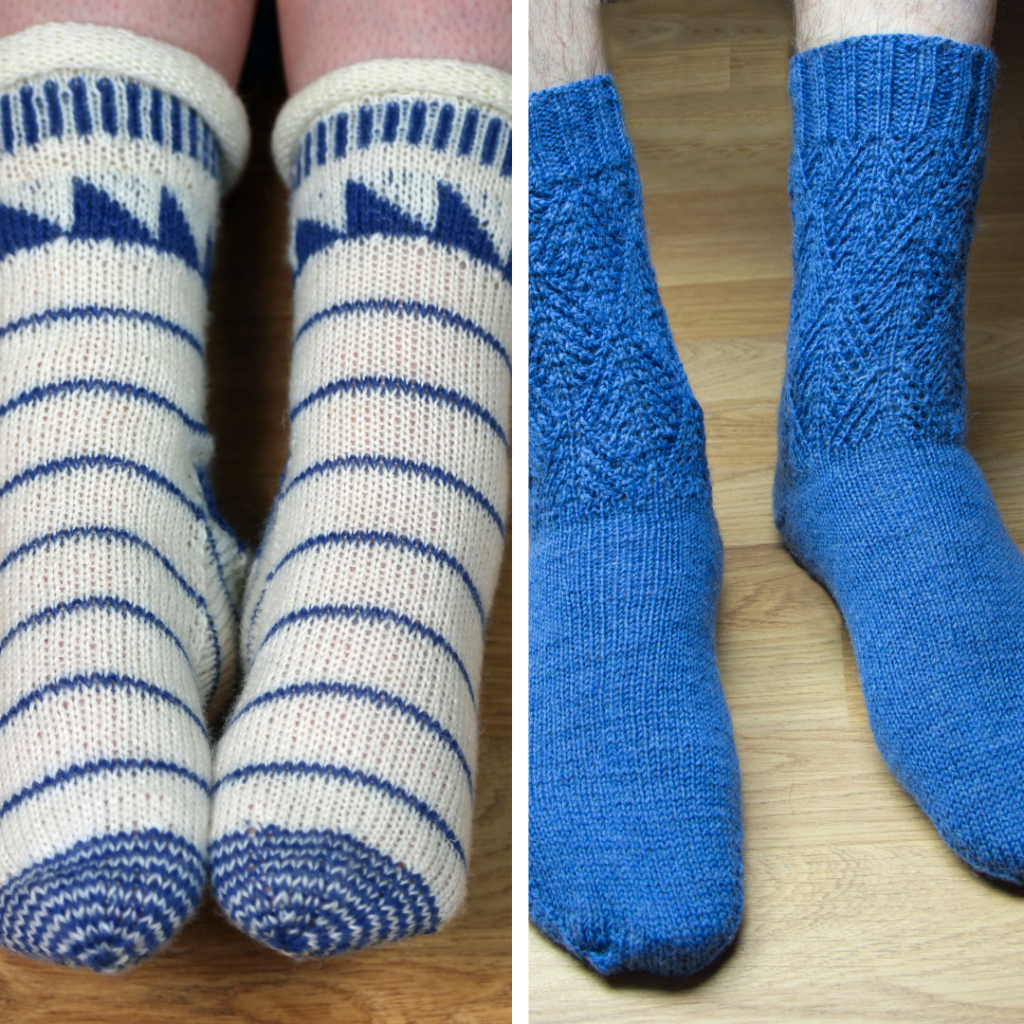
If you cast on 64 sts for both of these socks, the Time’s Racing on ahead Socks will have a circumference of 23.5 cm (9.25 inches), the Ribbed Leaf Socks will only have 17 cm (6.75 inches). Okay, that example was extreme. But with a gauge of 30 resp. 32 sts in 10 cm (4 inches) the resulting socks will still differ by 2 cm (0.75 inches).
Which Cast On should I use?
You need a very stretchy Cast On for socks. As mentioned above, socks are knit smaller than your actual leg circumference, so they need to be very stretchy. My favorite is the Old Norwegian Cast On, I have a video tutorial here:
Cuff
You can choose any pattern for your cuff, as long as it’s stretchy. That’s why we most often knit ribbed patterns – k1,p1; k2,p2; or k-tbl, p1 – whatever you like best. Mini cables are also very pretty.
Rnd 1: *K1, p2, k2, p2, k1; rep from * around.
Rnd 2: *K1, p2, 1/1 LC (or 1/1 RC), p2, k1; rep from *around.
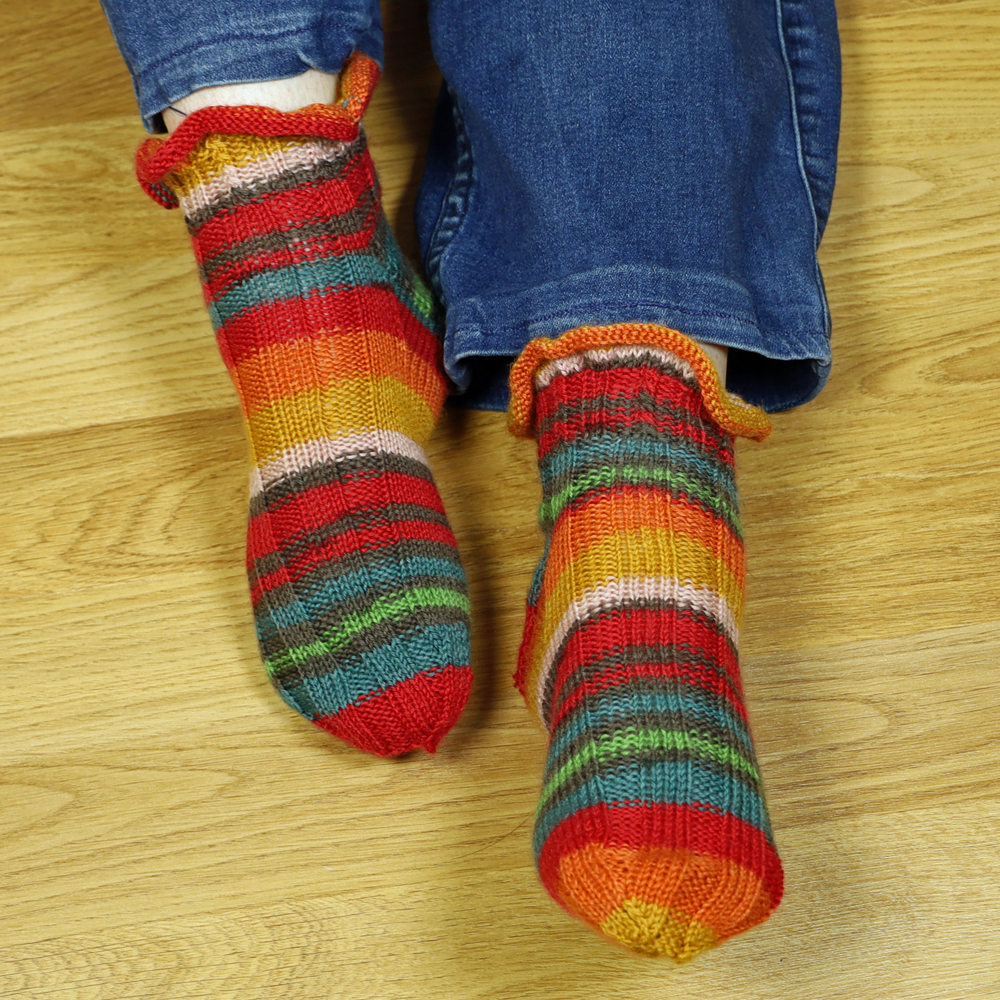
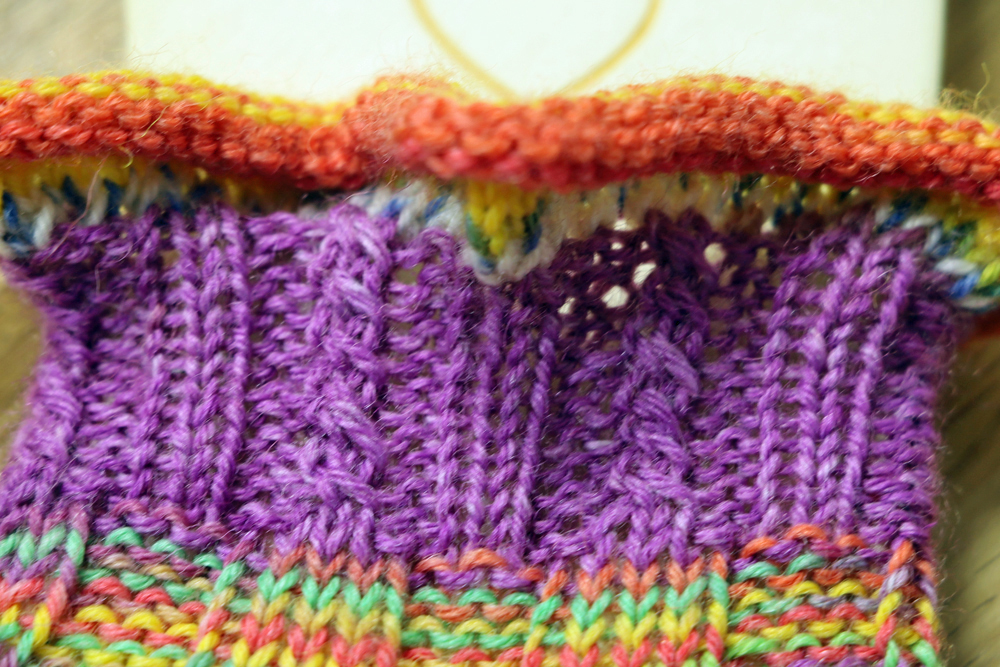
For a ruffled edge, CO double or three times as many sts as you actually need, knit a few rounds in, for example, Stockinette stitch or Seed stitch and then k2tog (or k3tog) around on the next rnd to get the correct stitch count for your leg.
You can knit the ribbing for as many rnds as you like. My favorite recipe is to knit as many rounds as a quarter of my sts. So, if I have a sock with 64 sts, I’ll knit 16 rnds of ribbing. A friend of mine knits as many rnds as the kid is old when knitting children’s socks which I find absolutely adorable <3
Which heel is right for me?
You can choose between a huge amount of heels – and that’s great because a well fitting heel is very important for a well fitting sock. You can divide them roughly into three groups:
- Heels with a heel flap (like the Heart-shaped heel, or the heel with a three-panel heel turn that you may have learned at school or from your mother or grandmother)
- Heels with a diagonal side seam (like the short-row heel)
- Afterthought heels
But which heel is right for you? For this we need to answer two questions.
- Do you have a low, medium, or high instep?
- Do yo have a narrow, medium, or wide heel?
If you know the answer to these questions, here is a table where you can look up your perfect heel. If not, we’ll find out below.
For the heels written in italic, I have a tutorial here!
| low instep | medium instep | high instep | |
| narrow heel | Short-row heel | Round short-row heel | |
| medium heel | Peasant heel Afterthought Heel | Round heel | |
| wide heel | Three-panel-heel Hybrid heel | Heart-shaped heel Plain heel |
Do you have a high instep?
There are two ways to test that.
What does your foot look like when it’s standing straight on the floor while you are sitting or standing? Is it completely flat? Do you see a little arch? A big arch? Is the foot flat while you’re standing but there’s a small arch while you’re sitting?
- When you’re sitting as well as when you’re standing your foot is flat on the floor: You have a low instep.
- When you stand, your foot is flat on the floor. When you sit, a small arch appears: You have a medium instep.
- When you’re sitting as well as when you’re standing you see a small arch: You have a medium instep.
- When you’re sitting as well as when you’re standing you see a high arch: You have a high instep.
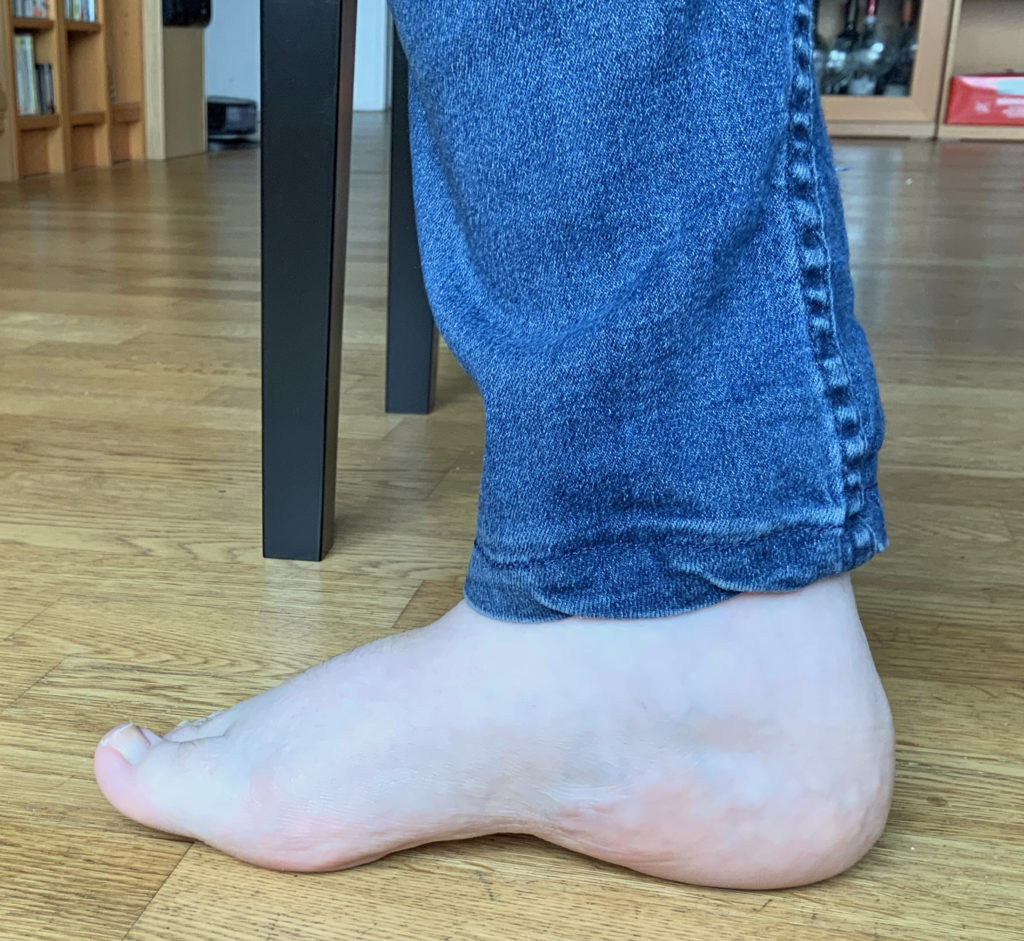

A second way to find out your instep height is the wet test. Put your foot into a bowl with water, big enough that your foot has enough space and enough water to fully cover the underside of your foot. Then put your foot onto a solid surface like a carton. Do not move your foot, just press it down for a few seconds. What does the resulting footprint look like?
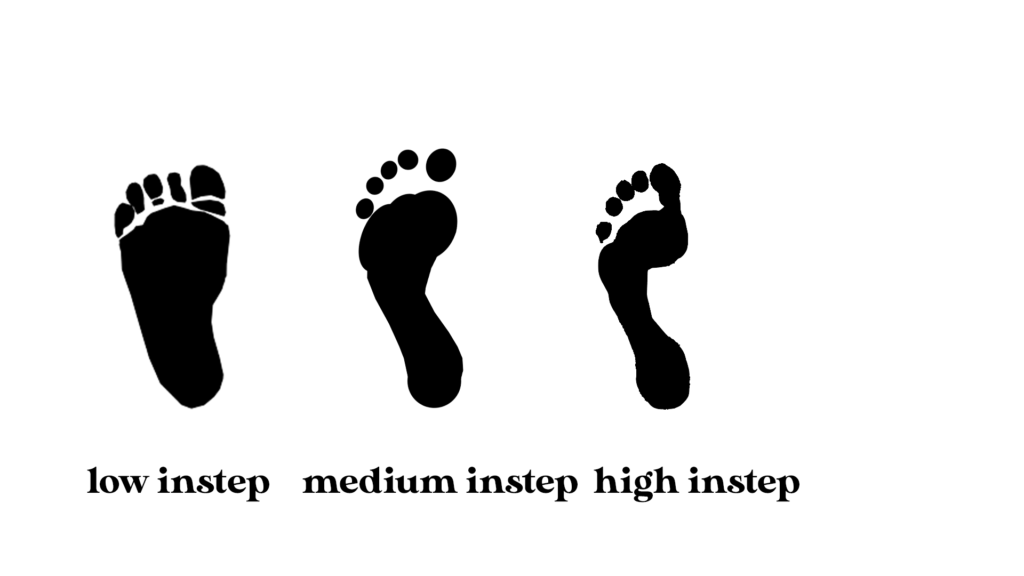
The footprints are Photoshop brushes by Brusheezy.com (Brushes by Brusheezy)
If you see a complete footprint, you have low instep. If you see an indentation, you have a medium instep. If you mainly see the ball of the foot and the heel, you have a high instep.
Do you have a wide heel?
I tried to find data here and I can tell you that it’s almost impossible to find numbers. Maybe you need to buy wide shoes, but I bet someone out there will tell me in a minute that they need wide shoes but have a narrow heel.
I found an article in Nature magazine (who would have thought I’d cite Nature on my knitting blog… :D), which – among else – gives the heel width in comparison to the foot length for men and women in Asia, Europe and North America.

Source: Jurca, A., Žabkar, J. & Džeroski, S. Analysis of 1.2 million foot scans from North America, Europe and Asia. Sci Rep 9, 19155 (2019). https://doi.org/10.1038/s41598-019-55432-z, zu finden hier: https://rdcu.be/cWvSy
Interesting for us are the two graphs on the right. For the article, the researches analyzed 1.2 million foot scans. On the x-axis, you see the foot length in mm, on the y-axis the mean heel width. The red line is for Europe, the blue line for North America and, the green one for Asia. The upper picture is for men, the lower one for women. If your heel width differs a lot from the measurements in the graph, you may have a narrow or wide heel.
In the two pictures in the middle, you see the mean instep height, so you can compare your results from above 🙂
Instep height was measured as shown in part D of the picture below – at 55 % of the foot length (measured from the heel) straight up.
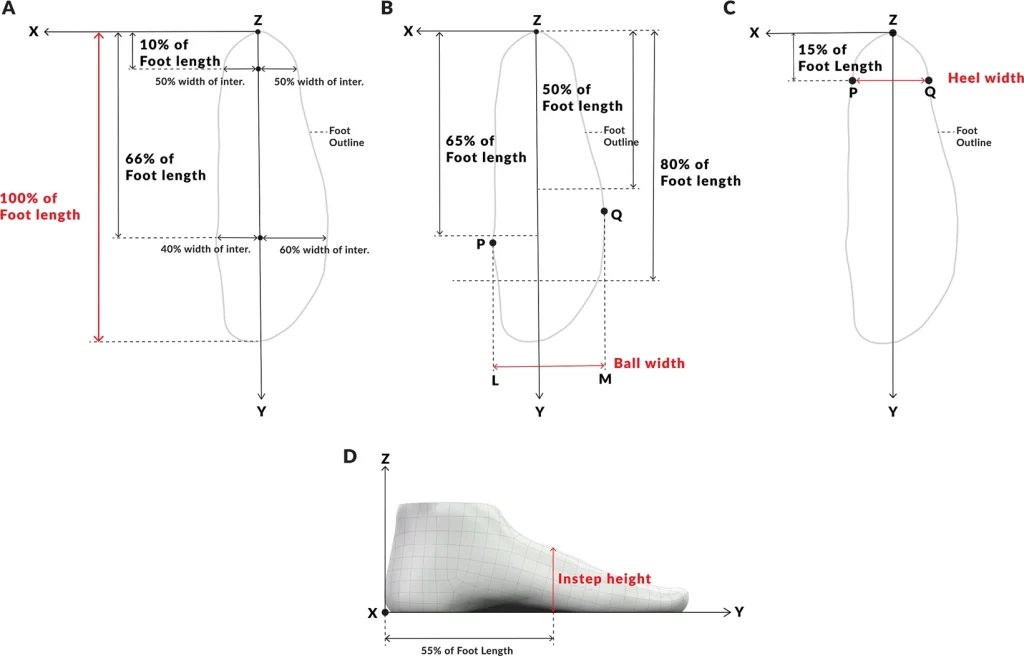
Quelle: Jurca, A., Žabkar, J. & Džeroski, S. Analysis of 1.2 million foot scans from North America, Europe and Asia. Sci Rep 9, 19155 (2019). https://doi.org/10.1038/s41598-019-55432-z, zu finden hier: https://rdcu.be/cWvSy
Which toe is right for you?
… and when do you start knitting it?
There are rules of thumb – the most common ones are to start the toe when the sock covers your little toe or when you need 5 cm (2 inches) more length. But now we’ve taken so much care – measured, photographed, and even made our feet wet – we won’t settle for rules of thumb now, right?
In my patterns, I tell you how many cm (or inches) the toe measures when you knit at the same row gauge that I did, and how many rounds the toe has in case your row gauge differs from mine.
If you don’t have all this info in your pattern or you’re knitting without one, you can easily calculate how long your toe is going to be.
Number of rnds in the toe
—————————————– * 10
Number of rnds in 10 cm
Number of rnds in the toe
—————————————– * 4
Number of rnds in 4 inches
Example: If your toe has 15 rnds and you’re knitting at a gauge of 40 rnds in 10 cm (4 inches), you’re toe will be (15/40)*10 = 3.75 cm (1.5 inches) long.
And which toe is the right one for you?
I can’t offer you any scientific Nature articles or formulas here – look at your toes! What do they look like? Round? Pointy? Square? Do you have a very prominent big toe and can draw a straight, steep line while your toes get shorter?
The toe that fits you the best is the one that looks most similar to your toes! For all toes in the following list I have a tutorial here!
If your big toe needs a lot of space, try the anatomical wedge toe.
Square: Wedge toe with decreaes every 2nd round.
Round: Flower toe or French toe
Pointy: You have a lot of choices here, like Star toes, Spiral toes, Propeller toes, or the wedge toe you may have learned in school – many resting rounds in the beginning and then less and less.
If your toes are pointy, you may want to close your sock toes by cinching. When about 8 sts remain, cut the yarn leaving a long tail, thread it on a tapestry needle and pull it through the remaining stitches twice while pulling them tight.
If your toes are wider, try grafting them in Kitchener stitch instead – I have a blog post for that so you never have to look up how that works again! https://knittedinswitzerland.ch/?p=2492
And now I wish you happy knitting and always perfectly fitting socks!
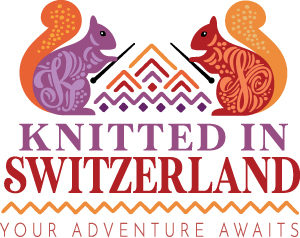
Great, Thanks for sharing stuff
Great, Thanks for sharing